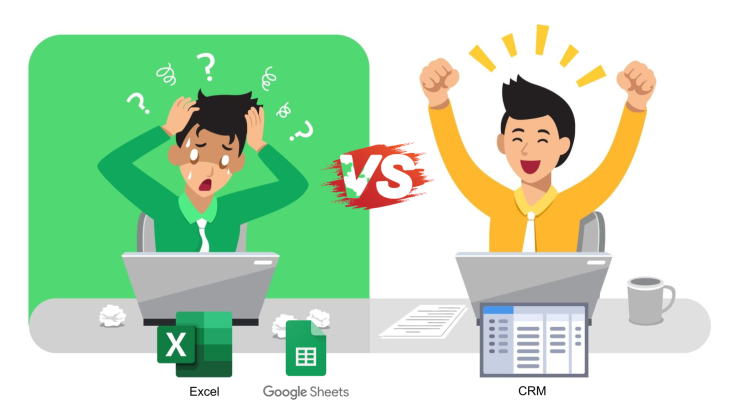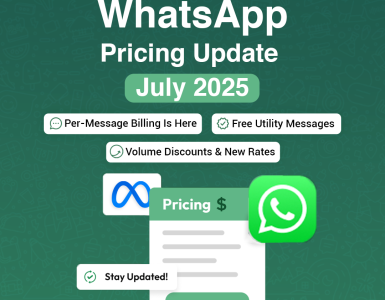Introduction
Excel and Google Sheets are popular tools, widely adopted in a variety of business environments due to their user-friendly design, flexibility, and their capacity for basic data processing. However, these tools fall short when it comes to managing complex customer relationship dynamics and large datasets, where a Customer Relationship Management (CRM) system thrives. The following points outline the reasons why CRM systems are better suited for this type of data management.
CRM Vs Excel Vs Google Sheets A Quick Comparison at Glance
| Feature | CRM | Excel | Google Sheets |
|---|---|---|---|
| Data Capacity | High, handles large datasets | Low, slows down with large data | Low, slows down with large data |
| Mobile Access | Full functionality via mobile | Limited functionality on mobile | Limited functionality on mobile |
| Integration | Seamless with other tools | Limited integration | Limited integration |
| Custom Data Views | Available | Not available | Not available |
| Relational Data | Displays relationships | Doesn’t display relationships | Doesn’t display relationships |
| Data Analytics | Advanced analytics & forecasting | Limited analytics | Limited analytics |
| Reminders | Built-in reminders & follow-ups | Not available | Not available |
| Business Visibility | Provides real-time insights | Doesn’t provide real-time insights | Doesn’t provide real-time insights |
| 360° Customer View | Available | Not available | Not available |
| Workflow Automation | Available | Not available | Not available |
Poor Data Capacity and Efficiency
Excel and Google Sheets, while ideal for smaller data sets, struggle with large data. The load time significantly increases when a spreadsheet crosses 10,000 rows, thereby slowing down productivity and efficiency. In contrast, CRM systems are built to handle large datasets effortlessly. This capacity allows businesses to store and access vast amounts of customer data without experiencing any significant load times or performance degradation.
The Real World Impact
Imagine a company, let’s call it Company A, which has been using Excel to manage its customer data. As the company grows, its customer database expands beyond 10,000 rows in Excel. The employees start to experience slow load times, leading to delays in data access and overall inefficiency. On the other hand, their competitor, Company B, uses a CRM system. Despite handling an even larger customer database, Company B experiences no slowdowns, maintaining optimal efficiency due to the CRM’s high data capacity.
No Mobile Accessibility
Most CRM systems have mobile applications or mobile-friendly views that make accessing customer data on the go easier. On the other hand, Excel and Google Sheets do not provide mobile applications that fully preserve the desktop functionality. This lack of mobile optimization can lead to inconvenience for teams who need to access customer data remotely or while traveling.
The Real World Impact
Take the example of a sales representative working remotely. They have client meetings and need access to updated client information. If their company is using Excel or Google Sheets, they might struggle with the mobile versions of these platforms, which often lack the full functionality of their desktop counterparts. Conversely, if the company uses a CRM system with a mobile application, the representative could effortlessly access client data, making their job easier and more productive.
Few Seamless Integration
CRM systems typically have the ability to seamlessly integrate with other software tools that a business uses. This integration allows all relevant data to be consolidated in one place. Excel and Google Sheets, however, lack this seamless integration feature, creating data silos and reducing overall efficiency.
The Real World Impact
Consider Company C, using Google Sheets, which also relies on multiple other software for email marketing, sales, and customer support. Their data is siloed across different platforms, leading to inefficiencies and incomplete customer profiles. Alternatively, Company D, using a CRM, has all its data integrated into one platform, facilitating smoother operations and more detailed customer understanding.
No Custom Data Views
Excel and Google Sheets provide a one-size-fits-all view of data, which can clutter the user experience when several people need to access the same file simultaneously. CRM systems, however, offer custom data views, providing each user with a tailored view that focuses on what’s relevant to them.
The Real World Impact
Let’s take a team of marketers using Excel to track campaign performance. The spreadsheet is filled with various data types, from budget figures to conversion rates. For the social media manager, the conversion rates are crucial, while the CFO is interested in the budget. Yet, they both see the same cluttered view in Excel. With a CRM, each could have a customized view, focusing on the most relevant data for their roles.
No Relational Data Management
While spreadsheets are excellent for listing information, they fail to show the relationships between different datasets. CRM systems are designed to show how different data entries are related to each other, providing a more comprehensive view of customer relationships.
The Real World Impact
Consider a hotel using Google Sheets to manage customer data. They have separate sheets for reservations, customer contacts, and customer preferences. The disconnect between these sheets makes it challenging to get a comprehensive understanding of their customers. A CRM, however, would easily relate these data sets, providing a complete view of each customer’s history and preferences.
Poor Data Analytics and Forecasting
With CRM, businesses have powerful data analytics at their disposal, allowing them to monitor and forecast business performance more efficiently. CRM systems also come equipped with customizable dashboards for visual data representation. Excel and Google Sheets offer limited data analytics capabilities, making it harder for businesses to monitor and predict their performance accurately.
The Real World Impact
Company E uses Excel for its sales data, struggling to make accurate forecasts or derive meaningful insights due to Excel’s limited analytical capabilities. Meanwhile, Company F, using a CRM, leverages advanced analytics and forecasting tools to predict future sales trends accurately and make data-driven decisions.
No Reminder and Follow-up Tools
CRM systems come with built-in reminder and follow-up tools, making it easy to keep track of tasks, follow up on leads, and ensure no opportunities are missed. Excel and Google Sheets lack these capabilities, increasing the chances of oversight and lost opportunities.
The Real World Impact
A sales team using Google Sheets might struggle with manual follow-ups and reminders, possibly leading to missed opportunities. However, a sales team using a CRM can set automated reminders and follow-ups, ensuring no lead is forgotten or opportunity missed.
Lack of Business Visibility
With CRM, business owners can get clear visibility into the actions of their team members and their interactions with customers. This level of insight is nearly impossible to achieve with Excel or Google Sheets, which lack the necessary tracking and reporting capabilities.
The Real World Impact
An eCommerce store owner using Excel has limited visibility into the day-to-day activities of the customer service team. They can’t track how many customer issues are being resolved or how long it takes. With a CRM, this business owner could have real-time visibility into these metrics, leading to better management and decision-making.
Lack of 360-Degree Customer View
CRM systems offer a 360-degree view of each customer, including their history, preferences, and previous interactions. This level of detail is impossible to capture and maintain effectively in Excel or Google Sheets, where data can quickly become outdated, incomplete, or difficult to navigate.
The Real World Impact
Consider a bank using Google Sheets to manage customer data. They have separate sheets for loans, account balances, and customer interactions, making it difficult to get a complete picture of each customer’s relationship with the bank. Conversely, a bank using a CRM could quickly get a 360-degree view of each customer, improving service and understanding.
Limited Workflow Automation
CRM systems come equipped with workflow automation capabilities, allowing routine tasks to be automated, saving time, reducing human error, and increasing efficiency. Excel and Google Sheets, on the other hand, lack this automation capability, leading to more manual work and potential for errors.
The Real World Impact
A software company uses Excel to track bug reports. Every time a bug is reported, an engineer has to manually assign it to a team member, wasting valuable time. However, a similar company using a CRM with workflow automation could have this process automated, freeing up time for the engineers to focus on solving the bugs instead.
Conclusion
While Excel and Google Sheets have their strengths, they fall short in several key areas when compared to CRM systems.
Don’t let your business be held back by the limitations of Excel and Google Sheets. Choose Picky Assist Modular CRM, designed specifically with your business needs in mind. From managing large datasets with ease to providing seamless integration, custom data views, advanced analytics, and workflow automation, Picky Assist offers the functionality you need to thrive. Benefit from real-time business visibility, comprehensive 360° customer views, and the convenience of mobile access. Take the first step towards transforming your customer relationship management today. Get in touch with our team to start your journey with Picky Assist CRM. We’re excited to help you drive your business to new heights.
Frequently Asked Questions
What is a CRM system?
A CRM (Customer Relationship Management) system is a technology platform designed to manage and analyze customer interactions and data throughout the customer lifecycle, with the goal of enhancing business relationships, retaining customers, and boosting sales.
How can a CRM system benefit my business?
A CRM system can significantly benefit your business by streamlining customer data management, offering actionable insights, improving customer service, automating workflows, and increasing sales. It centralizes customer information, making it easier for teams to collaborate and understand customer needs.
How does CRM compare to Excel in managing business data?
While Excel is primarily a spreadsheet tool for manual data entry and basic calculations, a CRM is designed specifically for customer management. CRM systems provide advanced analytics, seamless integrations, and an interface tailored to track and nurture customer relationships, which Excel lacks.
In what ways is CRM different from Google Sheets for customer management?
Google Sheets, similar to Excel, is a spreadsheet tool. A CRM, on the other hand, offers specialized features such as relational data views, workflow automation, and real-time business insights. Google Sheets may lack the depth and functionality required for comprehensive customer management that a CRM system offers.
What advantages does a CRM offer over Excel in business operations?
CRM systems offer a multitude of advantages over Excel, including the ability to handle large datasets efficiently, mobile-friendly interfaces, seamless integrations with other business tools, personalized data views for users, advanced analytics and forecasting tools, built-in reminders, and workflow automation capabilities. These features enable businesses to have a comprehensive and dynamic view of their customer interactions.
How can CRM systems improve the efficiency of sales teams compared to using spreadsheets?
CRM systems centralize and organize customer data, provide tools to track and nurture leads, automate repetitive tasks, and offer insights into customer behavior and sales trends. This level of functionality enables sales teams to focus on selling rather than data management, which might be the case with traditional spreadsheets.
Why is a 360-degree customer view important, and how does CRM facilitate this?
A 360-degree customer view offers businesses a comprehensive understanding of each customer by centralizing all their interactions, purchases, preferences, and feedback. CRM systems facilitate this by aggregating data from various touchpoints, allowing businesses to tailor their approach and service to each customer effectively.
Are CRM systems more secure than storing data in Excel or Google Sheets?
While both Excel and Google Sheets have security features, CRM systems are built with enterprise-level security in mind. This includes stringent encryption, regular backups, and role-based access controls. Businesses can be assured that their sensitive customer data is protected and compliant with industry standards when using a CRM system.
Can a CRM system integrate with other tools and software I use in my business?
Yes, most CRM systems, including Picky Assist CRM, are designed to offer seamless integration capabilities. This allows businesses to connect the CRM with various other tools they use, creating a unified platform and eliminating data silos.
How does the data analytics capability of a CRM compare to that of Excel?
While Excel offers basic data analytics and charting tools, CRM systems provide far more advanced and tailored analytics. CRMs offer dashboards, real-time data updates, forecasting tools, and the ability to generate comprehensive reports, which are crucial for businesses aiming to make data-driven decisions.







Add comment